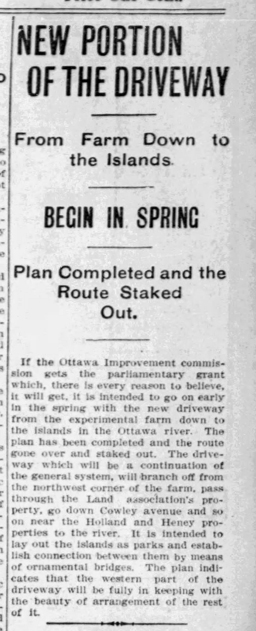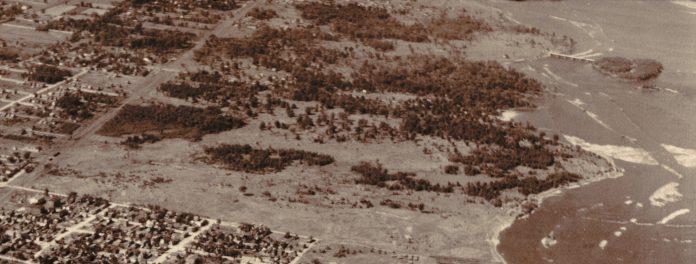By Dave Allston
Champlain Park is one of Ottawa’s most beautiful neighbourhoods, long a hidden gem, located along the Ottawa River waterfront, away from the busy main streets and nestled between Island Park Drive and Tunney’s Pasture.
The history of the neighbourhood is not just tied to the laying out of a residential district back in 1903. It was the politics and strategies associated with the land and, in particular, the three Ottawa River islands—over which the Champlain Bridge now runs—that shaped the early days of Champlain Park.
It was to these islands that Robert H. Cowley had a vision of the Ottawa Improvement Commission (OIC), forerunner to the NCC, running a western extension of the Queen Elizabeth Driveway. If he could succeed in bringing the driveway to the islands, then the land to the south of the islands would become quite valuable as the route of the driveway extension.
At the time, the future Champlain Park land was rocky, brush-covered, with dense, thickly-wooded areas, ill-suited for farming or even residential purposes, hence why the land was idle into the 1900s.
Cowley was the son of Captain Daniel Keyworth Cowley, who had been a successful riverboat captain on the Ottawa River for nearly 40 years. The captain retired to Richmond Road in 1868, acquiring a grand stone manor house about where Mailes Avenue runs today and ran a modest 185-acre farm. Cowley would have been nine years old when he arrived in the neighbourhood— an area in which he grew up and a place he deeply appreciated, eventually, becoming one of the area’s first big investors and developers.
He became a teacher, working his way up to Public School Inspector for Carleton County, replacing his brother-in-law and friend Archibald Smirle (another local figure) upon Smirle’s death in 1897. Cowley would go on to become Chief Inspector for Public and Separate Schools of Ontario in 1911.
However, in 1893, at the age of 34, just prior to his appointment as head of the Science Department at Ottawa Collegiate, Cowley made his first plunge into the local real estate market. He purchased 15 acres at the northwest corner of his father’s farm and laid out a small subdivision which he called “Ottawa West,” between Richmond and Scott, Rockhurst and Western.
He had the real estate bug: in July 1896, he acquired the land north of the CP Rail tracks—which is now the transitway. Looking back, 125 years later, Cowley’s motives to acquire this future Champlain Park property are unclear, but the $6,000 price was probably right. Cowley surely saw the investment potential of the land alongside the river and the three islands to the north. Soon after, he also acquired the parcel of land immediately to the west, giving him the full area between Latchford and Carleton.
In 1899, Sir Wilfrid Laurier established the OIC to take on larger projects to help beautify Ottawa. One of its first projects was the creation of the Queen Elizabeth Driveway (built between 1900-1902), and soon came the proposal of having a western extension.
Here’s where the savvy of Cowley kicked in. In the fall of 1902, he wrote to the Commissioner of Crown Lands about the three islands in the Ottawa River to have his claim to the islands recognized. According to real estate law at the time, as the landowner in proximity, Cowley owned first rights for application for ownership.
With that confirmation in hand, Cowley then wrote to the OIC Chairman H.N. Bate, offering to waive his claim to the islands, and, more importantly, that, “there would be no difficulty in securing, in the immediate future, a free and ample right of way from the Experimental Farm to these islands.”
His pitch included an offer to come view the land, confident that they would appreciate the “practicality and general attractiveness” of the area. If Cowley could get the OIC to run the western driveway to the three islands, rather than somewhere else to the west, his property would balloon in value.
Cowley did not receive a reply right away. In fact, it would be several years until he would.
In the meantime, Cowley decided to make his property more appealing. On Aug. 31, 1903, Cowley filed Carleton County Plan 219, laying out the majority of Champlain Park from Carleton Avenue on the east to Patricia Avenue on the west. He left the portion to the west to Latchford off, awaiting news on the driveway extension.
He named his new subdivision “Riverside Park”—the name “Champlain Park” would not arrive until the 1950s—and made the shoreline and its natural sandy beach the focal point of the new neighbourhood. In fact, Cowley did not promote Riverside Park as a place to build year-round homes. Instead, Riverside Park was advertised as a summer resort. In an era before cars, the cool river breezes, extensive shady mature tree coverage, open grove areas, and sandy beach made the park a popular spot for Ottawa residents to live for the summer or to visit for camping or picnicking.
Cowley was happy to allow for visitors to come and use his property and likely was even hesitant to sell lots in the first couple of years. If the driveway extension were to come to fruition, the lots would be worth three times or more what they were worth at the time. Yet, the more people he could bring to Riverside Park to enjoy the water and view the potential of the three islands just off shore, the better his chances were of securing the driveway route his way.

The first lots did sell in September 1903: railway mail clerk Robert S. Montgomery purchased two lots at the extreme north end of Carleton Avenue at the water’s edge. He would construct a large cottage on this lot two years later: “Riverside Lodge” (civic addresses did not exist at the time—each cottage instead was known by name).
The first cottage built in the Champlain Park neighbourhood was “The Cedars,” constructed by carpenter William Smith in 1904, which still stands today in a much-expanded form at 243 Carleton Ave.
The two major Ottawa newspapers of the era wrote about the dream-like conditions of the park: the fresh air, the tranquility and the slow pace of life. They wrote of the growth and construction of new cottages, the social comings and goings, parties and events, and even local politics and community issues. A century later, the stories conjure images of a closely-knit community that would come together each summer as one large family.
Riverside Park became arguably the most popular resort in the vicinity. Over time, year-round houses would be constructed, and the neighbourhood would slowly shift from being a cottage resort to a regular west Ottawa neighbourhood. The last vestiges of the cottage era remain in the few final cottages that stand, but the expropriation of the north half of the neighbourhood in the 1950s for the creation of the Ottawa River Parkway and the intensification of Champlain Park over the last 20 years, has, sadly, removed nearly all traces of the Riverside Park days.
Back to Cowley: his big coup would come in fall 1906, when Ontario Premier James Whitney visited Ottawa for an interprovincial conference, and it was reported that the OIC had a discussion with Whitney about the acquisition of the three islands.

Cowley moved quickly. On Nov. 24, 1906, he wrote back to Bate, reiterating his offer to waive his claim to the islands and to provide free access for the driveway route. Bate must have accepted immediately, for on the morning of Nov. 27, it was announced that the OIC had made a deal with the provincial government to acquire the islands.
By January 1907, the Minister of Agriculture had given approval to run the western driveway through the farm. A total of eight landowners offered the OIC free right-of-way to the islands, competing for the route. Cowley had the inside track, as withdrawing his claim enabled the OIC to acquire the islands quickly. Unsurprisingly, later that year, it was announced that the new driveway would run through Cowley’s property from Richmond Road to the river.
Due to the existing Ottawa West and Riverside Park subdivision, the new driveway was required to wind in an odd, diagonal route to the river to make it work. But make it work they did, and Cowley reaped the benefits. Cowley began offering Riverside Park lots for sale at higher prices, promoting the coming driveway.
In January 1908, it was announced that the OIC would begin construction of Island Park Drive that year. But funding issues arose, partially around the fact that the OIC discovered that the area flooded heavily each year and that portions of the planned roadway would spend the spring months under as much as 15 feet of water. By 1911, the driveway plan was considered a “mistake” and cancelled. Investors who had gobbled up lots were not happy and felt misled. WWI further delayed any new plans.
However, on Christmas Eve 1920, it was announced that the Island Park Drive was back on — a project designed to help with the high post-war unemployment in Ottawa. After briefly considering Holland Avenue for the driveway instead, the OIC returned to the original Riverside Park plan. Work began on the afternoon of July 11, 1921. Portions of Island Park Drive opened throughout 1923, the stretch to Bate Island in 1927, and, finally, to Quebec in 1928, bringing to fruition the vision that Robert Cowley had thirty years prior, and which, ultimately, had given birth to Champlain Park.
